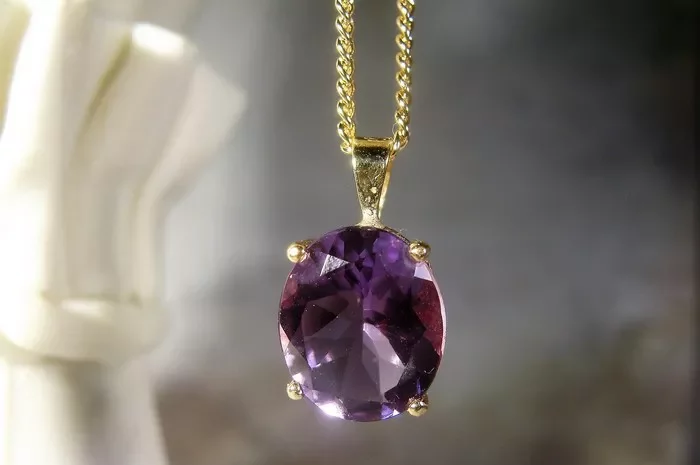Amethyst, a variety of quartz with a striking violet hue, has been cherished for its beauty and mystical aura for centuries. Its popularity in jewelry, particularly in the form of necklaces, continues to grow, making it a target for imitation and fraud. To ensure that you are purchasing a genuine and high-quality amethyst necklace, it is essential to understand the characteristics that define this gemstone and the methods used to authenticate it. As a professional jewelry appraiser, I will provide a comprehensive guide on how to distinguish the best genuine amethyst necklace, using simple language and logical reasoning.
Introduction to Amethyst Necklaces
Amethyst necklaces have adorned necks for millennia, symbolizing wisdom, sobriety, and peace. This gemstone’s popularity is attributed to its captivating color, which ranges from delicate lavender to deep, almost royal purple. However, with the increasing demand for amethyst jewelry, the market has also seen a surge in imitations and synthetic gemstones. To avoid purchasing a fake or low-quality amethyst necklace, it is crucial to possess the knowledge and skills necessary to authenticate this gemstone.
Understanding the Characteristics of Genuine Amethyst
Before diving into the methods of authentication, it is important to understand the unique characteristics of genuine amethyst. These characteristics will serve as the foundation for distinguishing a real amethyst necklace from its imitations.
Color: The most striking feature of amethyst is its color. Genuine amethyst displays a range of violet hues, from light lavender to deep purple. The color should be even and well-saturated, with no noticeable patches or streaks of different colors.
Clarity: Clarity refers to the internal flaws or inclusions within a gemstone. Genuine amethyst can contain natural inclusions, such as tiny crystals, fluid-filled cavities, or cracks. However, these should not dominate the gemstone or detract from its overall appearance. A high-quality amethyst necklace will have a clean and transparent appearance, with minimal internal flaws.
Hardness and Durability: Amethyst has a hardness of 7 on the Mohs scale, making it suitable for everyday wear. However, it can still be scratched or damaged if not properly cared for. A genuine amethyst necklace should be made of durable materials and set in a sturdy mounting to protect the gemstone.
Cut and Polish: The cut and polish of a gemstone can greatly affect its appearance and value. A well-cut amethyst necklace will have facets that are evenly spaced and aligned, creating a sparkle and brilliance that enhances the gemstone’s color. The polish should be smooth and free of scratches or abrasions.
Methods of Authenticating a Genuine Amethyst Necklace
Now that we have a solid understanding of the characteristics of genuine amethyst, let’s explore the methods used to authenticate a genuine amethyst necklace.
Visual Inspection: The first step in authenticating a genuine amethyst necklace is to perform a visual inspection. Look closely at the gemstone’s color, clarity, and cut. Compare it to known samples of genuine amethyst to ensure that it matches the expected characteristics.
UV Light Testing: Genuine amethyst will fluoresce under ultraviolet light, displaying a red or pink glow. This is a reliable method of distinguishing genuine amethyst from its imitations, as synthetic gemstones may not exhibit the same fluorescence.
Specific Gravity Testing: The specific gravity of a gemstone is the ratio of its weight to the weight of an equal volume of water. Genuine amethyst has a specific gravity of approximately 2.65. By measuring the specific gravity of the gemstone, one can determine if it is consistent with that of genuine amethyst.
Refractive Index Testing: The refractive index of a gemstone is a measure of its ability to bend light. Genuine amethyst has a refractive index range of 1.544 to 1.553. Using a refractometer, one can measure the refractive index of the gemstone and compare it to the expected range for genuine amethyst.
Heat Conductivity Testing: Genuine amethyst has a relatively low heat conductivity compared to other gemstones. By using a thermal conductivity tester, one can measure the gemstone’s heat conductivity and compare it to known values for genuine amethyst.
Certificate of Authenticity: Finally, the most reliable method of authenticating a genuine amethyst necklace is to obtain a certificate of authenticity from a reputable gemological laboratory. This certificate will provide detailed information about the gemstone’s characteristics, including its color, clarity, cut, and carat weight, as well as the results of any gemological testing performed.
Conclusion
Distinguishing a genuine amethyst necklace from its imitations requires a combination of knowledge, skills, and tools. By understanding the characteristics of genuine amethyst and using the methods of authentication outlined in this guide, one can ensure that they are purchasing a high-quality and genuine amethyst necklace. Remember, the best way to protect yourself from fraud and ensure that you are getting what you pay for is to always deal with reputable jewelers and gemological laboratories.
Related topic:
- What Is Raw Amethyst Good For
- What is the Spiritual Use and Significance of Amethyst?
- What Is the Significance of Amethyst


